Car heater blows cold air
Car heater blows cold air — causes and fixes
Heater blows cold
Car heaters aren’t that complicated; they’re just little radiators with a blower, temperature controls and a cabin air filter. Hot engine coolant runs through the heater core and your blower runs cabin air past the fins. That’s it. So let’s take a look at the possible causes.
#1 Cause of car heater blows cold or cool air—Low coolant level.
Low engine coolant is the #1 cause of low or no heat, especially at idle. When the coolant level is low, the water pump isn’t turning fast enough to circulate whatever coolant is left in the system. If your coolant level is low, your car heater will blow cold. When moving, it may blow cool air.
#2 Cause of car heater blows cold— Thermostat stuck in the open position.
The thermostat regulates engine coolant temperature by opening and closes as the engine heat changes and more or less air passes across the radiator. If the thermostat is stuck open or near the open position, it will allow too much cooling, resulting in lukewarm heat inside the cabin.
#3 Cause of car heater blows cold— Plugged heater core
If you haven’t kept up on coolant 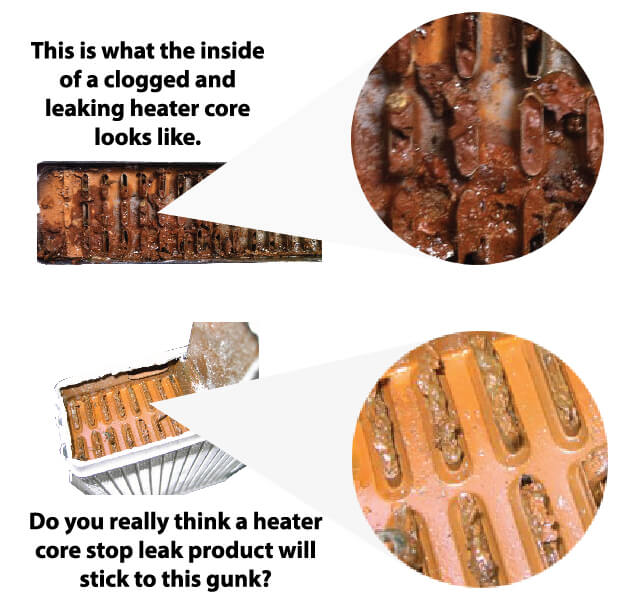 changes, the coolant system can corrode. Since the tubes in the heater core are much smaller than the tubes in the radiator, the heater core will plug up first. Once plugged, hot coolant can’t circulate.
changes, the coolant system can corrode. Since the tubes in the heater core are much smaller than the tubes in the radiator, the heater core will plug up first. Once plugged, hot coolant can’t circulate.
A totally plugged heater core won’t provide any heat, while a partially plugged heater core might provide lukewarm heat. Some heater cores can be cleaned out by filling with CLR cleaner overnight and then flushing with a garden hose. See this post for more information on how to flush a heater core.
#4 Cause of car heater not working—Faulty blend door or blend door actuator
The blend door is what varies the temperature of the air based on where you set the temperature dial. The blend door is moved by a cable, vacuum or an electric motor (see this post for more information on how a blend door works). Electric blend door actuators have a reasonably high failure rate, while vacuum-operated blend door actuators fail mainly due to vacuum hose leaks. In some cases, a binding blend door can cause repeat blend door actuator failures.
#5 Cause of car heater not working—Faulty heater control valve
Older cars varied the amount of heat by opening and 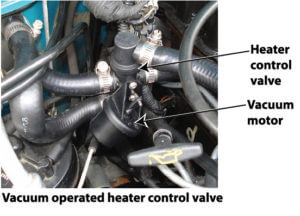 closing a valve that controlled coolant flow through the heater core. Most of these older valves were controlled by a cable. But some were controlled with vacuum motors. Car heater not working blowing cold air
closing a valve that controlled coolant flow through the heater core. Most of these older valves were controlled by a cable. But some were controlled with vacuum motors. Car heater not working blowing cold air
No heat in car — Check coolant level first
If your car has some heat when you’re driving but no heat when stopped that’s usually a sign of low coolant or a failing water pump. When you’re stopped and the  engine is running at a slower speed, the water pump can’t force enough coolant through the heater core. But when you’re driving, the higher water pump speed can pump some coolant up to the heater core. To fix no heat in the car condition caused by low coolant, simply add the proper coolant to the reservoir to bring it up the recommended level.
engine is running at a slower speed, the water pump can’t force enough coolant through the heater core. But when you’re driving, the higher water pump speed can pump some coolant up to the heater core. To fix no heat in the car condition caused by low coolant, simply add the proper coolant to the reservoir to bring it up the recommended level.
If the reservoir is empty or low, refill with the proper coolant and drive the vehicle to check for heater operation. Then find out why the system is low on coolant.
No heat in car due to a clogged heater core
Every car and truck has a heater core; a small radiator that transfers heat from engine coolant to air passing over it from the blower motor. The heater core is located in the passenger compartment that receives hot coolant from the engine. If you look under the hood, you’ll see two rubber hoses connecting to the heater core inlet and outlet right at the firewall See photo below.
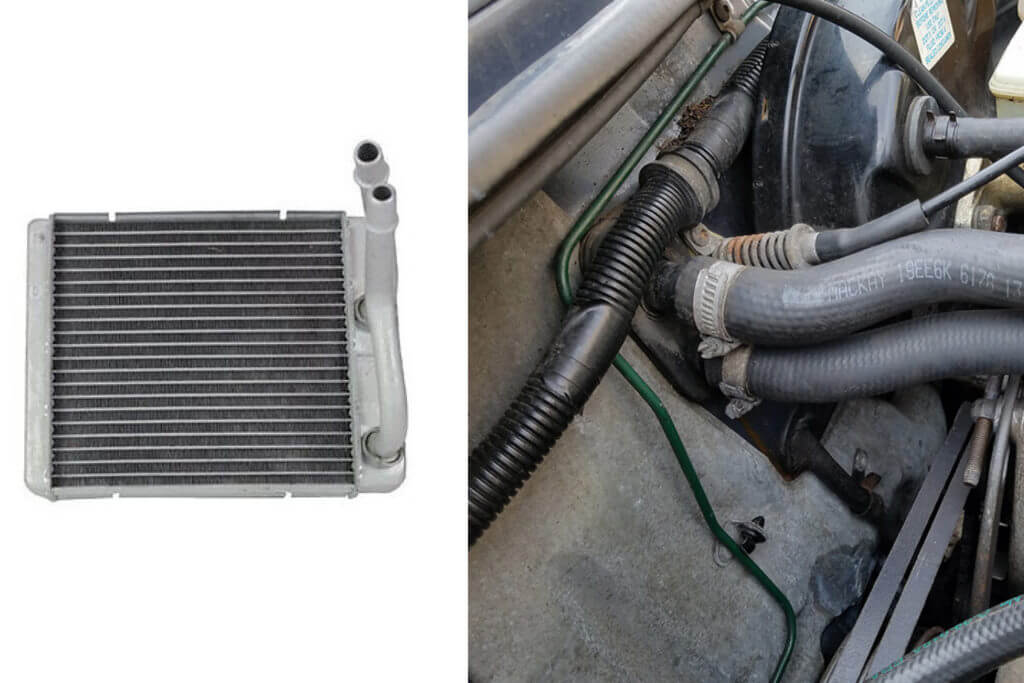
Heater core and hose connections at firewall
With the engine warmed up, touch both the inlet and outlet hoses to your heater core. Even if your heater core is operating properly, both the inlet and outlet hoses should be the same or near the same temperature. If one hose is cold and the other hot, that means the coolant isn’t flowing properly through the heater core. That can be caused by a clogged heater core or an air pocket in the heater core.
To fix no heat in car due to a clogged heater core, you can try flushing as a first step. See this post to learn hose flush a heater core by yourself.
See this post on how heater cores fail
No heat due to stuck open thermostat
Here’s the dead giveaway symptom of a stuck open thermostat: You get more heat when you’re stopped than you do when you’re driving. That’s because a thermostat is supposed to regulate the flow of coolant through the engine to maintain it at a set temperature. If the thermostat is stuck in the full open position, it allows full-time circulation. In other words, it’s OVER-COOLING the engine. That overcooked coolant simply doesn’t have enough heat left to warm the passenger cabin.
At a stop sign, the water pump doesn’t turn as fast so coolant doesn’t circulate as fast and can pick up more heat from the engine. So you get more heat from your heater.
Once you start driving and the water pump speeds up, overcooling begins again and you lose heat.
Some drivers place carboard in front of your radiator to increase heat output. That’s just stupid. That will cause uneven temperatures in the radiator across the radiator. Just replace the thermostat and you’ll be back in business.
No heat in car due to a failed blend door actuator or heater control valve
Late-model vehicles use an electric motor to move a “blend door” to adjust how much
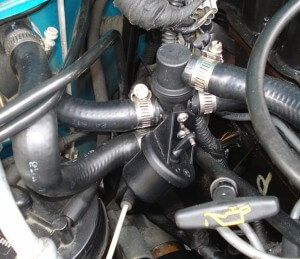
The heater control valve may have more than one hose. Check the shop manual to determine which is the feed hose
heat is added to the air coming from the blower motor.
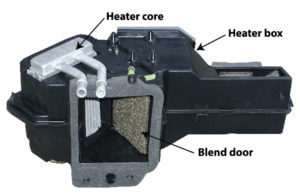
Heater box showing heater core and blend door
Older vehicles use a heater control valve that controls how much hot coolant is directed into the heater core. The heater control valve can be moved by a cable or vacuum.
An electric blend door actuator can fail in any position. Locate the blend door actuator under the dash and watch the shaft when you vary the temperature knob. If the shaft doesn’t move, then either the actuator is bad or the blend door is stuck. Disconnect the electrical connector from the blend door actuator and then remove the actuator retainer screws. Move the door by hand to
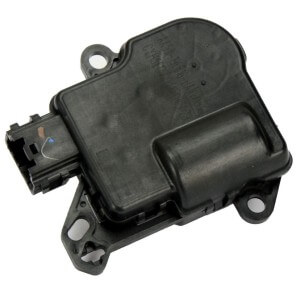
An electronic blend door actuator opens and closes a blend door to regulate the air temperature in your car
see if it opens and closes easily. If it does, then chances are the actuator is bad. However, you could be facing a situation where the heater control module isn’t commanding the actuator to open and close. To diagnose that situation, you’ll need a wiring diagram and a digital voltmeter.
Most electric blend door actuators are simply reversible electric motors with a position sensing mechanism to tell the heater control module the actual position of the blend door. In this design, you’ll see two wires to run the electric motor and three wires to the position sensor. Isolate the two wires to the motor and attach your digital voltmeter to those two wires. Then command a different heat setting. You should see battery voltage on your meter. If not, suspect a bad heater control module.
A blend door actuator is a fraction of the price of the heater control module and fails far more often than the control module, so if you’re going to guess at a fix, replace the actuator first.
Possible stuck open thermostat. An engine thermostat that’s stuck open will cause you to feel cold air when driving and slightly warmer air when stopped. In addition to the cold air problem, you’ll notice a drop in gas mileage.
See this post for more information on blend doors and actuators
No heat in car because no air is flowing
If there’s no airflow, you’re not going to get heat. Here are the possibilities:
• Blown blower motor fuse
• Bad blower motor resistor
• Bad blower motor
• Bad blower motor speed switch
• Bad blower motor ground.
Always start your diagnosis by checking the blower motor fuse. If the fuse is blown, don’t just replace it—there’s a reason it failed. If you don’t fix the root cause, the fuse will blow again.
The most common reason for a blown blower motor fuse is an air restriction caused by a clogged cabin air filter or a clogged heater core (debris on the heater core fins that won’t allow air to pass through). Remove the cabin air filter and check it’s condition. If it’s plugged, install a new filter and fuse and see if that solves the problem.
The second most common reason for a blown blower motor fuse is a failing blower motor that’s drawing too many amps. Test the amperage draw on the blower motor at all speeds. If the amperage draw is close to the fuse value, the motor is bad and should be replaced.
©, 2016 Rick Muscoplat
Posted on by Rick Muscoplat
